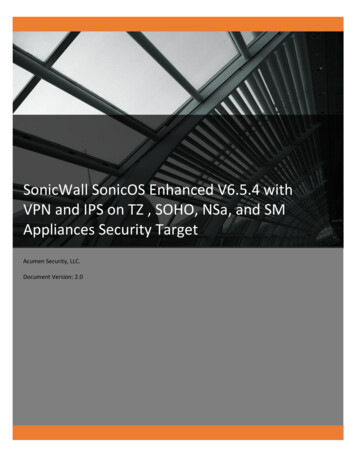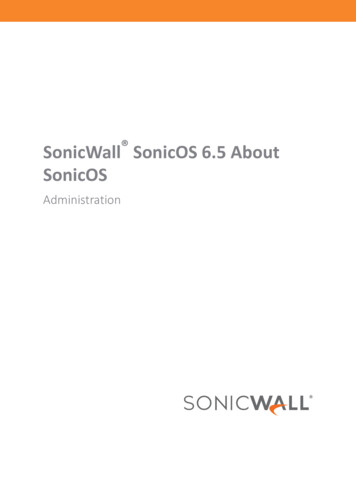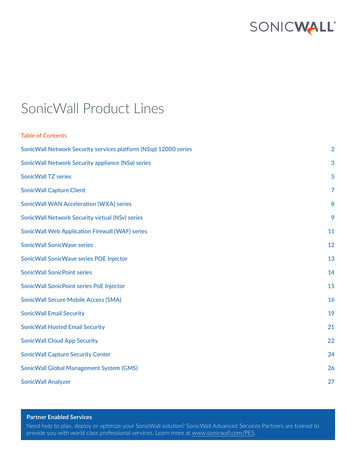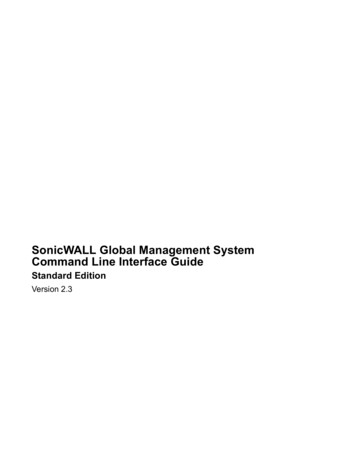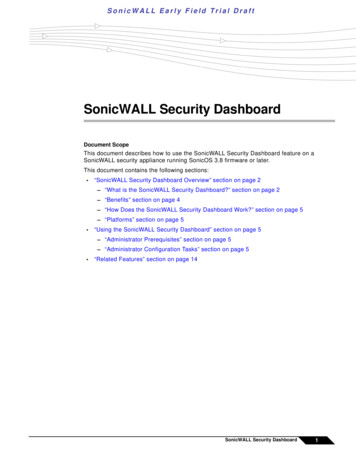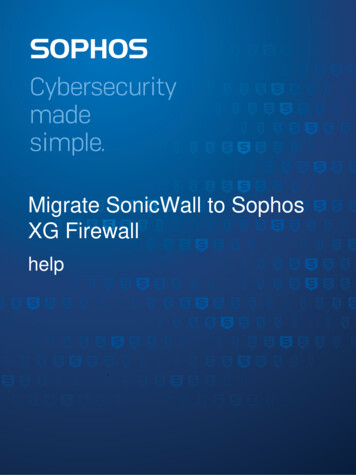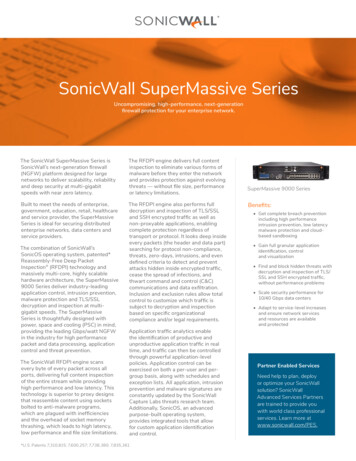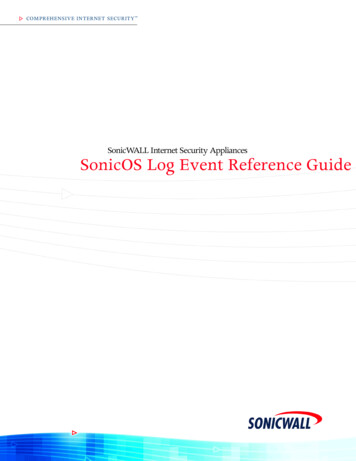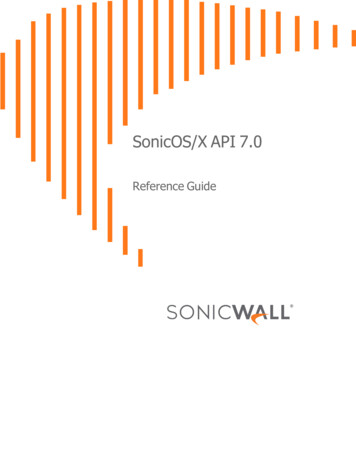
Transcription
SonicOS/X API 7.0Reference Guide
ContentsAbout SonicOS API7SonicOS API FunctionEnabling through the Management InterfaceEnabling through the CLI788Supported Request MethodsSupported HTTP Headers89Supported HTTP MIME TypesExamples910Status and Error RepresentationHTTP Status CodesApplication/JSON121313Client Authentication15ExamplesExample - Commit Pending ConfigurationExample - Address Object API Calls161616API Authentication17Authentication Methods17Two-Factor Authentication18RFC-2617 HTTP Basic Authentication24RFC-7616 HTTP Digest Access AuthenticationMD5 SupportSHA-512/256 SupportIntegrity ProtectionSession Variant2525252526Public Key AuthenticationPublic Key Challenge/ResponseRSA PaddingPassword Size Limits and RSA Key Sizes26262828Challenge-Handshake Authentication (CHAP)Pros and Cons of the Different Schemes2930Session SecurityChallenge-Free and Challenge/Response OperationPassword and Password-Hash SavingOperation After Non-Digest AuthenticationNonce Resetting3131313232SonicOS/X API 7.0 Reference GuideContents2
API: Config - Pending33About Modifying Configuration API33EndpointSchema StructureSchema Attributes333434ExamplesGET Pending Changes (Unchanged)GET Pending ChangesPOST Pending Changes34343435API: Restart37About Restarting API37Endpoint37Schema Structure38Schema Attributes38Example38API: Address Objects – IPv439Endpoint39Schema StructureObject: Address ObjectCollection: Address ObjectSchema Attributes40404141API: Address Objects – IPv644Endpoint44Schema StructureObject: Address ObjectCollection: Address ObjectsSchema Attributes45454646API: Address Objects – MAC49Endpoint49Schema StructureObject: Address ObjectCollection: Address ObjectSchema Attributes49505050API: Address Objects – FQDN53Endpoint53Schema StructureObject: Address ObjectCollection: Address ObjectSchema Attributes53545454SonicOS/X API 7.0 Reference GuideContents3
API: Address Groups — IPv457Endpoint57Schema StructureObject: Address GroupCollection: Address GroupSchema Attributes58585959API: Address Groups — IPv662Endpoint62Schema StructureObject: Address GroupCollection: Address GroupSchema Attributes63636464API: Schedule Objects68Endpoint68Schema StructureObject: ScheduleCollection: ScheduleSchema Attributes68697071API: Service Objects78Endpoint78Schema StructureObject: Service ObjectCollection: Service ObjectSchema Attributes78798080API: Service Groups85Endpoint85Schema StructureObject: Service GroupCollection: Service GroupSchema Attributes86868687API: Zones89Endpoint89Schema StructureObject: ZoneCollection: ZoneSchema Attributes89909293API: DNS123Endpoint123SonicOS/X API 7.0 Reference GuideContents4
Schema StructureObject: DNSSchema Attributes123123125API: Interfaces – IPv4130Endpoint130Schema StructureObject: Interface – IPv4Collection: Interface – IPv4Schema Attributes130130132133API: NAT Policies – IPv4145Endpoint145Schema StructureObject: NAT Policies – IPv4Collection: NAT Policies – IPv4Schema Attributes145146147149API: NAT Policies – IPv6160Endpoint160Schema StructureObject: NAT Policies – IPv6Schema Attributes160160163API: NAT Policies – NAT64171Endpoint171Schema StructureObject: NAT Policies – NAT64Collection: NAT Policies – NAT64Schema Attributes171172173174API: Access Rules – IPv4180Endpoint180Schema StructureObject: Access Rules – IPv4Collection: Access Rules – IPv4Schema Attributes180181183184API: Access Rules – IPv6199Endpoint199Schema StructureObject: Access Rules – IPv6Collection: Access Rules – IPv6Schema Attributes199200202203SonicOS/X API 7.0 Reference GuideContents5
API: Route Policies – IPv4218Endpoint218Schema StructureObject: Route Policies – IPv4Collection: Route Policies – IPv4Schema Attributes218219220221API: Route Policies – IPv6228Endpoint228Schema StructureObject: Route Policies – IPv6Collection: Route Policies – IPv6Schema Attributes228229230231SonicWall Support236About This Document237SonicOS/X API 7.0 Reference GuideContents6
1About SonicOS APIllSonicOS API FunctionlEnabling through the Management InterfacelEnabling through the CLISupported Request MethodslSupported HTTP HeaderslHTTP Status CodeslStatus and Error RepresentationlClient AuthenticationlExamplesSonicOS API FunctionSonicOS API provides an alternative to the SonicOS Command Line Interface (CLI) for configuring selectedfunctions.SonicOS API is disabled by default in SonicOS. Any attempt to access SonicOS API while it is disabled results inan HTTP 403 Forbidden error. To use the SonicOS API, you must enable it, either through the SonicOSManagement Interface or from the CLI.SonicOS API is supported on all platforms running SonicOS 6.5.4 and higher.Topics:lEnabling through the Management InterfacelEnabling through the CLISonicOS/X API 7.0 Reference GuideAbout SonicOS API7
Enabling through the Management InterfaceTo enable SonicOS API through the management interface:1. Navigate to MANAGE System Setup Appliance Base Settings.2. Scroll down to the SonicOS API section.3. Select Enable SonicOS API.4. Click Accept.Enabling through the CLIStarting at the config# prompt:config( serial number )# administration(config-administration)# sonicos-api(config-administration)# commitSupported Request MethodsSonicOS API utilizes four of the methods defined in the HTTP protocol (RFC 7231 and RFC 5789) to create, read,update and delete (CRUD) resources. Supported HTTP request methods describes the supported HTTPmethods for management operations after authentication. Refer to Client Authentication for the methodssupported during authentication.Supported HTTP Request MethodsHTTP methodDescriptionGETRetrieves the specified resource or collection of resources. GET is a read-onlyoperation that does not alter appliance state or configuration. A GET operationshould not contain a request-body.POSTSubmits data to be processed by the specified resource or collection of resources. Inmost cases, the POST verb is used by SonicOS APIs to create and add a resource toa collection of resources (for example, add a new MAC address-object to collection ofobjects).PUTUpdates the specified resource. The data included in the PUT request-body replacesthe previous configuration.DELETEDeletes the specified resource or collection of resources.Supported HTTP Header Request And Response FormatsTypeExampleSonicOS/X API 7.0 Reference GuideAbout SonicOS API8
Text/plainGET /api/sonicos/address-objects/mac Accept: text/plainApplication/JSONPOST /api/sonicos/address-objects/mac Content-type: application/jsonAccept: application/json { "address object": { "mac": { "name":"001122334455" ,"address": "001122334455" ,"multi homed": true ,"zone":"LAN" } } }To configure all other parameters:config(C0EAE483FB86)# administration(config-administration)# sonicos-api(config-sonicos-api)# exit(config-administration)# commitSonicOS API or-bearer-tokenSupported HTTP HeadersContent-typeSpecifies the format (MIME type) of the request body (input).AcceptSpecifies the format of the response body (output).Supported HTTP MIME TypesSonicOS supports these HTTP MIME types:lText/plainlApplication/JSONThese HTTP headers define the request and response format:lContent-type - Specifies the format (MIME type) of the request body (input)lAccept - Specifies the format of the response body (output)NOTE: The headers can be used to obtain mixed input/output. See examples below for reference.SonicOS/X API 7.0 Reference GuideAbout SonicOS API9
tion/JSONWhen specified, the request and/or response body is expected to be in SonicOS API JSON format.RequestPOST /api/sonicos/address-objects/macContent-type: application/jsonAccept: application/json{"address object": {"mac": {"name": "001122334455","address": "001122334455","multi homed": true,"zone": "LAN" }} }ResponseHTTP/1.0 200 OKServer: SonicWALLContent-type: application/json; charset UTF-8{"status": {"success": true,"cli": {"depth": 1,"mode": "config mode","configuring": trueSonicOS/X API 7.0 Reference GuideAbout SonicOS API10
,"pending config": true,"restart required": "NONE"},"info": [{ "level": "info", "code": "E OK", "message": "Success." } ]} }Text/PlainWhen specified, the request and/or response body is expected to be in SonicOS CLI plain-text command format.Topics:lRequest 1lRequest 2Request 1GET /api/sonicos/address-objects/macAccept: text/plainResponseHTTP/1.0 200 OKServer: SonicWALLContent-type: text/plain; charset UTF-8address-object mac example address 001122334455zone LANmulti-homedexitRequest 2POST /api/sonicos/direct/cliContent-type: text/plainAccept: application/jsonaddress-object mac example address 001122334455zone LANmulti-homedSonicOS/X API 7.0 Reference GuideAbout SonicOS API11
exitResponseHTTP/1.0 200 OKServer: SonicWALLContent-type: application/json; charset UTF-8{"status": {"success": true,"cli": {"depth": 1,"mode": "config mode","configuring": true,"pending config": true,"restart required": "NONE"},"info": [{ "level": "info", "code": "E OK", "message": "Success." }]} }Status and Error RepresentationAll plain text output from the last backend CLI command executed is captured and returned to the client. If thecommand executed was not a show command and the requested operation succeeded, then the response bodyis empty. This is consistent with the CLI when executing a command via SSH or the serial console in that status isonly rendered to the console upon error.A JSON status object is guaranteed to be returned in the response body when performing a POST, PUT, orDELETE operation or upon error(s) encountered when processing a request.Topics:lHTTP Status CodeslApplication/JSONSonicOS/X API 7.0 Reference GuideAbout SonicOS API12
HTTP Status CodesSonicOS API uses standard HTTP status codes to report success or failure when servicing a request.HTTP Status CodesCodeStatus TextDescription200OKThe request succeeded.400Bad RequestAn invalid request was submitted. Verify that therequest URI is correct and that the request body is asexpected.401Not AuthorizedThe user is unauthenticated or lacks the requiredprivileges for the requested operation. This may beaccompanied by headers for initiating authentication,depending on the scheme(s) enabled for that.403ForbiddenThe request was understood by the server but denied.The response body notes the reason why the requestwas denied.404Not FoundThe resource specified was not found.405Method Not AllowedThe HTTP verb specified is not allowed or supportedby the resource specified.406Not AcceptableThe MIME type specified in the HTTP Content-typeand/or Accept header is not supported.413Request body too largeMaximum size of the request body was exceeded.414Request URL too longThe request URL exceeded the maximum size allowedor contains extra/unknown parameters (directories).500Internal Server ErrorThe request failed due to an internal server error. Theresponse body should note the reason why therequest failed.503No resourcesMaximum number of sessions was exceeded.Application/JSONA JSON status object is guaranteed to be returned in the response body when performing a POST, PUT, or DELETEoperation or upon error(s) encountered when processing a request.Topics:lSchema StructurelSchema AttributesSonicOS/X API 7.0 Reference GuideAbout SonicOS API13
Schema Structure{"status": {"success": {boolean},"cli": {"depth": {number},"mode": "{string}","command": "{string}","configuring": {boolean},"pending config": {boolean},"restart required": "{string}" },"info": [{ "level": "{string}", "code": "{string}", "message": "{string}" }. ] }}Schema us object.status.successboolean (true false)Boolean success flag. Refer to the status.infoarray for more detailed information as to whatcaused the error if the success flag is false.status.cliobjectCLI status.NOTE: This attribute is included only whenan API sent one or more commands to theCLI backend.status.cli.depthnumber (uint8)Current mode depth of the CLI:l0 top-level model 1 config modestatus.cli.modestringName of the current mode.status.cli.commandstringCommand last executed.NOTE: This attribute is only included uponcommand error(s).SonicOS/X API 7.0 Reference GuideAbout SonicOS API14
status.cli.configuring boolean (true false)Boolean configuring flag. Should always be trueupon one or more consecutive POST, PUT orDELETE API calls that modify the configuration.status.cli.pendingconfigboolean (true false)Boolean pending-config flag. Should always betrue upon one or more consecutive POST, PUTor DELETE API calls that modify theconfiguration. This flag should be cleared onceany/all pending changes are committed (saved).status.cli.restartrequiredstringAppliance restart status. To take effect, someconfiguration changes require an appliancerestart. These values indicate the type of restartneeded:NONEAPPLIANCECHASSISCHASSIS SHUTDOWNALL BLADESstatus.infoarrayInformational message(s).status.info.levelstringStatus level: info, warning, error.status.info.codestringStatus code. If success, E OK is returned, elseE {XXX} where XXX error code.status.info.messagestringStatus message.Client AuthenticationSonicOS API currently offers the following mechanisms for initial client authentication:lHTTP Basic Authentication (RFC 2617)lHTTP Digest Access Authentication (RFC-7616)lPublic Key AuthenticationlChallenge-Handshake Authentication (CHAP)lTime-Based One-Time Password (TOTP)/Bearer Token AuthenticationRegardless of the authentication mechanism used, only:lA single administrator can manage (modify configuration) at any given time. This remains true regardlessof where an admin logged in (web management UI, CLI, GMS, or SonicOS API).lUsers with full admin privileges are allowed to access SonicOS API.lA single SonicOS API session is currently allowed.For more information refer to API Authentication.SonicOS/X API 7.0 Reference GuideAbout SonicOS API15
ExamplesTopics:lExample - Commit Pending ConfigurationlExample - Address Object API CallsExample - Commit Pending ConfigurationAll SonicOS APIs that modify configuration (POST, PUT, DELETE) do not take effect immediately. Rather,configuration is staged and is not pushed to run-time config and saved to flash/permanent storage until APIclients explicitly execute a POST request to /api/sonicos/config/pending. This is the same behavior as in theSonicOS CLI and equivalent to invoking the commit command from the top-level config mode.Pending configuration can be canceled (deleted) at any time by executing a DELETE request to/api/sonicos/config/pending. Any/all pending configuration is canceled upon client session termination,whether due to idle-timeout or explicit logout. In this case, all unsaved changes are lost. It is the client'sresponsibility to either commit pending configuration after each POST/PUT/DELETE API call or maintain pendingchanges on the client side to be restored in a later session.EndpointEndpointHTTP method and icos/config/pendingSchema: N/ATopics:lSchemalExamplesExample - Address Object API CallsTopics:l# Create a new IPv4 Address Object named Web Serverl# Modify the Web Server Address Object host IPl# Delete the Web Server Address ObjectSonicOS/X API 7.0 Reference GuideAbout SonicOS API16
2API AuthenticationTopics:lAuthentication MethodslTwo-Factor AuthenticationlRFC-2617 HTTP Basic AuthenticationlRFC-7616 HTTP Digest Access AuthenticationlPublic Key AuthenticationlChallenge-Handshake Authentication (CHAP)lSession SecurityAuthentication MethodsSonicOS API supports four authentication mechanisms that share the same endpoint for client login and logout.EndpointHTTP Method & BodyURI: y1. Navigate to MANAGE System Setup Appliance Base Settings.2. Scroll down to the SonicOS API section.3. Select from the choices under Enable SonicOS API.lEnable RFC-7616 HTTP Digest Access AuthenticationlEnable digest algorithms: SHA256 or MD5lIntegrity protection: Disabled, Allowed, or Enforced.lUse session variant (password hashes in place of passwords): Disabled, Allowed, orEnforced.lEnable CHAP authenticationlEnable RFC-2617 HTTP Basic Access authenticationSonicOS/X API 7.0 Reference GuideAPI Authentication17
lEnable Public Key AuthenticationlRSA modulus (key/cipher size in bits): 2014 is the default.lRSA padding type: PKCS#1 v1.5 or PKCS#1 v2.0 OAEPlOAEP hash method: SHA-1, SHA-256, or OtherlOAEP mask (MGF1) method: SHA1, SHA-256, or OtherlEnable Two-Factor and Bearer Token AuthenticationlEnable session security using RFC-7616 Digest Access AuthenticationlCan hold user passwords received from the client.lMaximum nonce use: 10 by defaultNOTE: It is highly recommended to call delete api/sonicos/auth to log out of the API session, withbearer token or user name/password. Otherwise, the session is closed after a time of inactivity.NOTE: The settings for RFC-7616 Digest Authentication also apply to session security. If the settingsare disabled for RFC-7616, they are enabled for session security.Two-Factor AuthenticationSonicOS API supports Two Factor Authentication (TFA) for administrators and users who want to enable thesecurity feature from the Graphical User Interface (GUI) and API. This is an alternative to the other authenticationmechanisms described here and cannot be used along with those. Bearer Token Authentication is an alternativemethod of securing the management requests sent after authentication, as per the Open API Specification, andSonicOS/X API 7.0 Reference GuideAPI Authentication18
as used by Swagger. When two-factor authentication is used to log in on the API, then Bearer TokenAuthentication must be used in all the requests that follow it.To log in with TFA and use Bearer Token Authentication through the firewall:1. Enter your Username and Password in the SonicWall LOG IN page.2. Navigate to MANAGE System Setup Appliance Base Settings.3. Under the Administrator Name & Password section, scroll down to One-time Passwords Method:4. Choose TOTP from the drop-down menu.5. Scroll down to the SonicOS API section.6. Select Enable Two-Factor and Bearer Token Authentication (applies to built-in admin and local userwith TOTP only, post sonicos/tfa directly instead of sonicos/auth).7. Click ACCEPT.A message displays under the ACCEPT and CANCEL buttons next to Status indicating the configurationhas been updated.SonicOS/X API 7.0 Reference GuideAPI Authentication19
To use TFA and Bearer Token Authentication:1. Enter your Username and Password in the SonicWall LOG IN page.2. The SonicWall-proprietary bar code screen displays.3. Install either the Google Authenticator or Duo apps on your phone to implement two-step verificationusing TOTP for your appliance.4. Using the apps, scan the SonicWall bar code by positioning your phone lens window in front of the barcode.5. The apps then generate a security code that you enter into the text field next to 2FA Code:IMPORTANT: Remember to write down your eight-digit emergency scratch code somewhere for lateraccess as it is the only way to log in if you lose your mobile phone.6. Click OK.SonicOS/X API 7.0 Reference GuideAPI Authentication20
7. Click the Click here to continue . link in the next SonicWall bar code screen after you have succeededto UNBIND the TOTP KEY.SonicOS/X API 7.0 Reference GuideAPI Authentication21
8. Enter the code from the app in the 2FA Code field and click OK.9. After your password has been verified you successfully land in the appliance’s Base Settings page.NOTE: Administrators and users can also enforce the TFA and Bearer Token Authentication featureby going to System Setup Users Settings page.SonicOS/X API 7.0 Reference GuideAPI Authentication22
To log in with TFA and use Bearer Token Authentication through the API:1. Navigate to MANAGE Logs & Reporting API.2. Click on the HTTPS://SONICOS-API.SONICWALL.COM link under the SonicWall SonicOS APIAgreement section.3. Click Logout to log out of the firewall.4. The browser automatically links to the SWAGGER API open-source software user interface, whichdisplays. You can also use other API tools such as Postman and Linux Command cURL.NOTE: The Swagger tool works slowly sometimes so it may take a few seconds for the UI to appear.Also, not all browsers have the same speed of connection to Swagger and the other API apps.5. Post “tfa” with user name, password, and two-factor code to the firewall.6. Click Execute.7. Click Authorize when done.8. The bearer token is returned in the “tfa” response message.SonicOS/X API 7.0 Reference GuideAPI Authentication23
9. Click Authorize.10. Click Authorize again under Available authorizations.RFC-2617 HTTP Basic AuthenticationRFC-2617 HTTP Basic Authentication is the simplest method for client authentication. HTTP BasicAuthentication uses the standard Authentication HTTP headers to pass user credentials between the client andthe server. Because HTTP Basic Authentication provides no means for protecting the confidentiality of a user’scredentials, SonicOS API requires user credentials to be transmitted over HTTPS when this is enabled.For SonicOS API HTTP Basic Authentication, use the Linux command-line curl command with the -u option:SonicOS/X API 7.0 Reference GuideAPI Authentication24
lLogin:curl -k -i -u admin:password -X POST https://a.b.c.d/api/sonicos/authlLogout:curl -k -i -X DELETE https://a.b.c.d/api/sonicos/authRFC-7616 HTTP Digest Access AuthenticationSonicOS API supports the RFC-7616 HTTP Digest Access Authentication scheme as its most secure. It includes:lllllSecure authentication using SHA-256, extensible for other algorithms in the future.Replay prevention utilizing a counter that is incremented in each request and can be reset to any value atany time in replies from the firewall.An option for a “rolling nonce,” where an HTTP reply can optionally pass back a new nonce (randomnumber) to be used for the next request.Optional “integrity protection” where requests with entity body content can include that in the digestcalculation.An optional “session” variant that uses a SHA hash of the password instead of the password itself so thatthe SonicWall/client do not need to store the actual password.For SonicOS API HTTP Digest Access Authentication, use the Linux command-line curl command with the -uoption:lLogin:curl -k -i -u admin:password -digest -X HEAD https://a.b.c.d/api/sonicos/authMD5 SupportMD5 is supported with HTTP Digest Access Authentication to allow inter-operation with older software that doesnot support SHA-256, but it is disabled by default and use of SHA-256 instead is highly recommended.SHA-512/256 SupportAlthough RFC-7616 specifies the hashing scheme named “SHA-512/256,” which is an efficient hybrid betweenSHA-512 and SHA-256 (see FIPS 180-4), as an alternative to SHA-256, SonicOS does not currently support it.Integrity ProtectionIntegrity protection is an optional feature specified in RFC-7616 where the body content of a request is included inthe digest hash, hence providing protection against malware trying to change or replace that. This is not useful inSonicOS/X API 7.0 Reference GuideAPI Authentication25
the authentication request since no sensitive data is sent, but it is supported for session security and, if enabled,can be used there too.NOTE: curl’s latest digest authentication does not support integrity protection for requests with data content.Setting integrity protection on the SonicWall to Allow, rather than to Enforce, allows initial authenticationwithout integrity protection. Custom scripts can then use integrity protection to safeguard the content of theAPI management requests.Session VariantRFC-7616 specifies a mode of operation referred to as the session variant. A hash of the password, and someother fixed values, is used instead of the actual password. This allows the operation without needing to store thepassword in any retrievable way. This can be useful to enhance security on the client side when using local useraccounts, including the built-in admin. The client can then store the hash of the admin password, rather thanstoring the actual password.This can also be helpful on the SonicWall side during session security. Refer to Password and Password-HashSaving.Public Key AuthenticationThe SonicWall proprietary Public Key Authentication is an alternative secure scheme that, unlike digestauthentication, allows the password to be securely encrypted and sent from the client to the firewall. This isnecessary if session security is to be performed with accounts that are authenticated remotely viaLDAP/RADIUS/TACACS .Public Key Challenge/ResponseThe public key exchange utilizes the WWW-Authenticate and Authorization HTTP headers, compliant with theaccess authentication framework specified in RFC-7235 section 2, and with their auth-scheme specifyingSNWL-PK-AUTH.A client must first invoke a challenge from the firewall by making a request to /api/sonicos/auth. Any method canbe used for this, but it is suggested that a POST be used if the override parameter is to be set, or otherwise aHEAD request since no request data content is involved. This solicits a response as follows:HTTP/1.0 401 UnauthorizedServer: SonicWallWWW-Authenticate: SNWL-PK-AUTH type RSA, key "."An exception for authentication is with CHAP authenticated via RADIUS, but it is not compatible with then doingsession security.The client will then need to resend the request to /api/sonicos/auth with an Authorization header as follows:Authorization: SNWL-PK-AUTH user "admin", data "."SonicOS/X API 7.0 Reference GuideAPI Authentication26
The content of the key field in the challenge is the RSA public key, in ASN.1 type RSAPublicKey format (seeRFC-3447 section A.1.1) and base64-encoded. This is what comes between the BEGIN and END markers in anRSA key in a .pem file, concatenated into a single line (with the BEGIN/END markers not included). For examplewith this RSA key:-----BEGIN PUBLIC aH K2kfpHE2U7SDsbZMpdQu8vEYIdDlqrQx7BzQpfBGVy5CbTsJn RiGPNYjtFAL Ed9euWTlvaD7G OhIWFMCnPRIOFkZxwc1v Aqq8FY/A/nMYPYwIDAQAB-----END PUBLIC KEY-----It would be the string “MIGfMA0G.YwIDAQAB”. The client can take this string and save it as a .pem file,enclosed in ----- BEGIN PUBLIC KEY----- / -----END PUBLIC KEY----- header/footer. That can then be used withopenssl’s command-line RSA utility to encrypt a password using openssl by either of:echo -n password openssl rsautl -encrypt -pubin -inkey key-file.pem base64 -w 0echo -n password openssl pkeyutl -encrypt -pkeyopt rsa padding mode:pkcs1 -pubin \ -inkeykey-file.pem base64 -w 0Or if PKCS#1 v2.0 OAEP padding is selected (see below) by any one of:echo -n password openssl rsautl -encrypt -oaep -pubin -inkey key-file.pem base64 -w 0echo -n password openssl pkeyutl -encrypt -pkeyopt rsa padding mode:oaep -pubin \ -inkeykey-file.pem base64 -w 0echo -n password openssI pkeyutI -encrypt -pkeyopt rsa padding mode:oaep -pkeyopt \ rsaoaep md:sha256 -pkeyopt rsa mgf1 md:sha256 -pubin inkey key-file.pem base64 -w 0The “openssl rsautl” is now deprecated and using “openssl pkeyutl” is preferred. In the case of OAEP, the first twoforms above both use SHA-1 for the hashes in the OAEP padding, and the third form needs to be used for otherhashing methods (such as SHA-256, as in the above example). Note that the latter is not supported in allSonicOS version.The data field in the response holds the cipher data (encrypted password), base64-encoded (as output by theabove commands).The string could be piped through "fold -w 64" to break it into 64-character lines, as in the example above, but thatis not necessary and a .pem file with a single long line between the header/footer lines works fine.The following is an example bash script to send a public key authentication request to the firewall, extract thepublic key from the WWW-Authenticate challenge in the reply, use that to encrypt the password (with OAEPpadding using SHA-256) and then send the response back to the firewall:curl -k -i -s -X POST https:// ADDR/api/sonicos/auth grep 'WWW-Authenticate: SNWL-PKAUTH' \ sed -e 's/ .*key "/-----BEGIN PUBLIC KEY-----\n/' \ -e 's/"/\n-----END PUBLIC KEY-----/' pk.pemSonicOS/X API 7.0 Reference GuideAPI Authentication27
CIPHER (echo -n " PASSWORD" openssl pkeyutl -encrypt -pkeyopt rsa padding mode:oaep \-pkeyopt rsa oaep md:sha256 -pkeyopt rsa mgf1 md:sha256 -pubin -inkey pk.pem \ base64 -w 0)curl -k -i -s -H 'Authorization: SNWL-PK-AUTH user "' USERNAME'", data "' CIPHER'"' \-X POST https://192.168.168.32/api/sonicos/authRSA PaddingRSA defines two types of padding, the original one specified in PKCS#1 v1.5, and a more recent OAEP paddingspecified in PKCS#1 v2.0.PKCS#1 v2.0 utilizes SHA hashing and is more secure and preferred, but gives more size overhead, henceresulting in a smaller maximum password size for a given key size. Refer to Password Size Limits and RSA KeySizes.The type of padding to use is configurable, defaulting to OAEP. The client and firewall must be using the sametype of padding, and for security it is highly recommended that OAEP padding be used.OAEP padding uses two hashes (its primary hash and that for its MGF1 mask generation function) and in someversions of SonicOS these too are configurable. In both cases any hashing method that is supported byOpenSSL (the version used in SonicOS) can be used. The two do not need to be the same, but what the clientuses in the encryption must match what is configured on the firewall.Password Size Limits and RSA Key SizesThe maximum length of the password that can be encrypted depends on the chosen RSA key size (modulus) andpadding type, as follows:Key Bits Cipher Size Padding T
SchemaStructure 123 Object:DNS 123 SchemaAttributes 125 API:Interfaces-IPv4 130 Endpoint 130 SchemaStructure 130 Object:Interface-IPv4 130 Collection:Interface-IPv4 132

